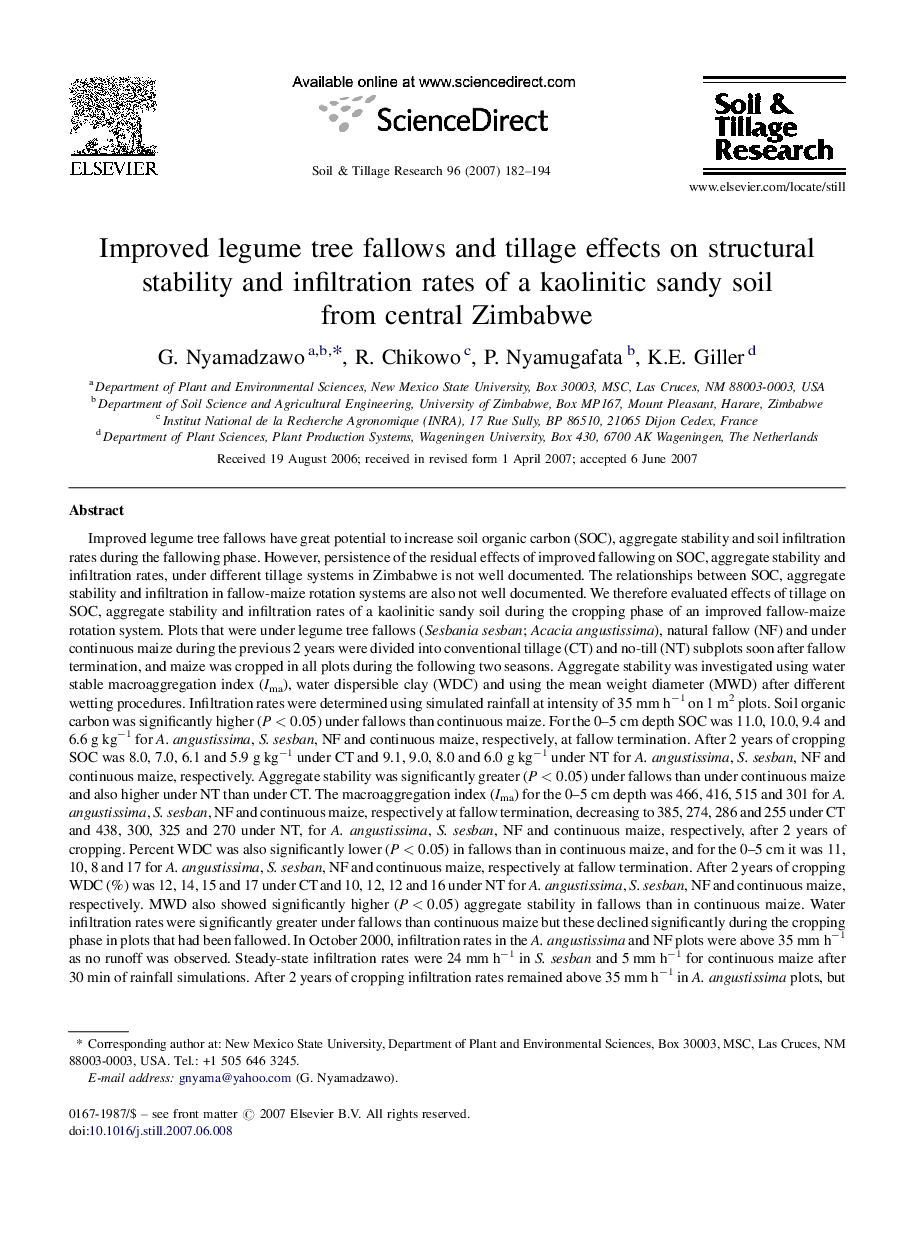| Article ID | Journal | Published Year | Pages | File Type |
|---|---|---|---|---|
| 306547 | Soil and Tillage Research | 2007 | 13 Pages |
Improved legume tree fallows have great potential to increase soil organic carbon (SOC), aggregate stability and soil infiltration rates during the fallowing phase. However, persistence of the residual effects of improved fallowing on SOC, aggregate stability and infiltration rates, under different tillage systems in Zimbabwe is not well documented. The relationships between SOC, aggregate stability and infiltration in fallow-maize rotation systems are also not well documented. We therefore evaluated effects of tillage on SOC, aggregate stability and infiltration rates of a kaolinitic sandy soil during the cropping phase of an improved fallow-maize rotation system. Plots that were under legume tree fallows (Sesbania sesban; Acacia angustissima), natural fallow (NF) and under continuous maize during the previous 2 years were divided into conventional tillage (CT) and no-till (NT) subplots soon after fallow termination, and maize was cropped in all plots during the following two seasons. Aggregate stability was investigated using water stable macroaggregation index (Ima), water dispersible clay (WDC) and using the mean weight diameter (MWD) after different wetting procedures. Infiltration rates were determined using simulated rainfall at intensity of 35 mm h−1 on 1 m2 plots. Soil organic carbon was significantly higher (P < 0.05) under fallows than continuous maize. For the 0–5 cm depth SOC was 11.0, 10.0, 9.4 and 6.6 g kg−1 for A. angustissima, S. sesban, NF and continuous maize, respectively, at fallow termination. After 2 years of cropping SOC was 8.0, 7.0, 6.1 and 5.9 g kg−1 under CT and 9.1, 9.0, 8.0 and 6.0 g kg−1 under NT for A. angustissima, S. sesban, NF and continuous maize, respectively. Aggregate stability was significantly greater (P < 0.05) under fallows than under continuous maize and also higher under NT than under CT. The macroaggregation index (Ima) for the 0–5 cm depth was 466, 416, 515 and 301 for A. angustissima, S. sesban, NF and continuous maize, respectively at fallow termination, decreasing to 385, 274, 286 and 255 under CT and 438, 300, 325 and 270 under NT, for A. angustissima, S. sesban, NF and continuous maize, respectively, after 2 years of cropping. Percent WDC was also significantly lower (P < 0.05) in fallows than in continuous maize, and for the 0–5 cm it was 11, 10, 8 and 17 for A. angustissima, S. sesban, NF and continuous maize, respectively at fallow termination. After 2 years of cropping WDC (%) was 12, 14, 15 and 17 under CT and 10, 12, 12 and 16 under NT for A. angustissima, S. sesban, NF and continuous maize, respectively. MWD also showed significantly higher (P < 0.05) aggregate stability in fallows than in continuous maize. Water infiltration rates were significantly greater under fallows than continuous maize but these declined significantly during the cropping phase in plots that had been fallowed. In October 2000, infiltration rates in the A. angustissima and NF plots were above 35 mm h−1 as no runoff was observed. Steady-state infiltration rates were 24 mm h−1 in S. sesban and 5 mm h−1 for continuous maize after 30 min of rainfall simulations. After 2 years of cropping infiltration rates remained above 35 mm h−1 in A. angustissima plots, but declined to 18 and 8 mm h−1 for NF, CT and NT respectively and 12 mm h−1 for S. sesban, CT and NT. It is concluded that legume tree fallows improved SOC, aggregate stability and infiltration rates, but these benefits accrued during fallowing decreased significantly after 2 years of cropping following the termination of fallows. The decrease in SOC and aggregate stability was higher under CT than NT. Coppicing fallows of A. angustissima were the best long-term fallow species when integrated with NT as improved soil physical properties were maintained beyond 2 years of post-fallow cropping.
